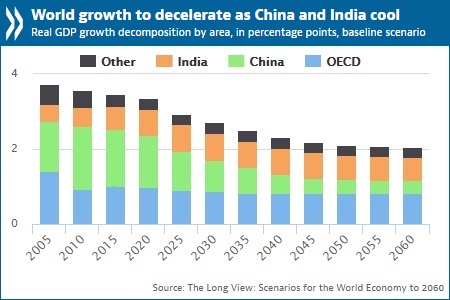OECD economic scenarios to 2060 illustrate the long-run benefits of structural reforms
Policy choices made today can have important positive effects on future living standards, according to new long-term economic scenarios released by the OECD.

The Long View: Scenarios for the World Economy to 2060 extends the usual short-run horizon of economic forecasters to better illustrate the potential benefits of reforms to education, governance, labour market policies and product market regulations, whose effects play out over decades.
In a “business-as-usual” reference scenario without significant reforms, living standards (GDP per capita) in the OECD countries improve by between 1½ and 2% per annum over the coming 40 years. Living standards in the BRIICS countries (Brazil, Russia, India, Indonesia, China and South Africa) grow faster, but decelerate from the 6% annual growth achieved over the last decade to just over 2% by 2060, leaving them at less than half the level seen in the leading countries.
India and China nevertheless take up a rising share of world output – between 20-25% of world GDP each by 2060, versus a bit more than 40% for the OECD countries – as the world’s economic centre of gravity continues to shift toward Asia. Meanwhile, demographic change weighs on living standards in advanced countries and creates substantial fiscal pressures, forcing governments to raise tax revenue by an average of 6½ percentage points of GDP to meet health and pension needs while preventing government debt from rising.
A number of alternative scenarios illustrate how policy and institutional reforms could boost future living standards, making use of previous OECD work that quantifies the impact of structural reforms. Lessons from alternative scenarios include:
● The BRIICS have substantial room to improve governance and educational attainment. In a scenario where both factors catch up with average OECD levels by 2060, living standards are 30% to 50% higher than in the reference scenario.
● Reforms through 2030 to make product market regulation in OECD countries as friendly to competition as in leading countries raise living standards by over 8% in aggregate (and as much as 15-20% in the countries currently furthest away from best practices, including Belgium, France, Italy and Spain).
● Bringing labour market policy settings in OECD countries up to those of leading countries raises the aggregate employment rate by 6½ percentage points by 2040, mostly via higher youth and female employment, helping to promote inclusiveness. Combined with reforms to contain healthcare cost inflation, this package would alleviate future fiscal pressures, more than halving the extra revenue required to stabilise government debt.
● Tying future increases in pensionable ages to life expectancy, as some countries are already doing, raises the aggregate employment rate of older people in the OECD by more than 5 percentage points by 2060.
Finally, in a negative scenario, the paper shows how slipping back on trade liberalisation – returning to 1990 average import tariffs – depresses long-run living standards by 14% for the world as a whole and anywhere from 15-25% in the most affected countries.
Source: Organization for Economic Co-operation and Development
- 234 reads
Human Rights
Ringing FOWPAL’s Peace Bell for the World:Nobel Peace Prize Laureates’ Visions and Actions

Protecting the World’s Cultural Diversity for a Sustainable Future

The Peace Bell Resonates at the 27th Eurasian Economic Summit

Declaration of World Day of the Power of Hope Endorsed by People in 158 Nations

Puppet Show I International Friendship Day 2020

